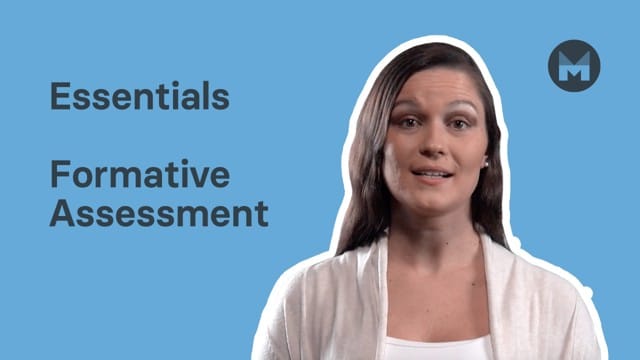Formative assessment strategies to improve student learning
In this guide
- Why formative assessment and how is it different from summative assessment?
- Why formative assessment matters for student success
- Low-prep formative assessment strategies for student success
- Using formative assessment data to guide instruction
- Tips for making formative assessment quick, consistent, and meaningful
Why formative assessment and how is it different from summative assessment?
Formative assessment is any assessment used to inform instruction.
Formative assessments are usually used in the moment or shortly after the assessment occurs to adjust instruction. Formative assessment happens during the learning process.
The most important aspect of formative assessment is that it allows for continuous improvement. Teachers can adjust their teaching to student needs and students are able to demonstrate their mastery. Teachers are able to more readily identify misconceptions and gaps.
Summative assessments are a way of ascertaining the students’ grasp of a topic or unit of work, are formally graded and recorded to mark students progress on that topic or unit before moving to the next unit of work. Often there is no chance of a second submission or altering student grades.
The most significant difference between formative and summative assessments is purpose. Formative assessments are designed to inform instruction. Their purpose is to determine if students are on track to master skills and content. Formative assessment is assessment for learning. Summative assessments are used to evaluate mastery of skills and content. Summative assessment is assessment of learning.
Due to their nature, these assessments are given at different times during the lesson cycle. Formative assessments occur during learning. Summative assessments are given at the end of the learning cycle.
Another difference between formative and summative assessments is that formative assessments are typically a more informal type of assessment. Sometimes teachers may not even use them as a graded assignment. Short quizzes, exit tickets, and discussion questions are all types of formative assessments. Summative assessments, on the other hand, contain more quantitative data and are used for evaluation of learning.
Why formative assessment matters for student success
1) Increased student engagement
Engaging students in the learning process is the challenge set before every teacher. Formative assessments help teachers to engage students because students are given frequent feedback. Through this increase in feedback, students are able to track their own understanding and make adjustments to their own learning.
Teachers are also able to make adjustments in real-time so that students do not go through the entire lesson confused or with misconceptions. If students understand the material being taught, they are more likely to be engaged in the learning.

2) Real-time adjustments
Through formative assessments, teachers are able to make real-time adjustments to their teaching that benefit students. Teachers can quickly identify misconceptions and gaps. Areas of need can be addressed. This means that students and teachers are not waiting until the summative assessment to recognize when students do not understand concepts.
3) Clear learning goals
The alignment of learning goals, teaching, and assessments is pivotal for student success. Clear learning goals are a part of this alignment process. Knowing what the point of their learning is, helps students to understand how the teaching and learning are connected to how they demonstrate mastery.
Goals, of any kind, direct a person towards the steps needed to accomplish the goal. Learning goals are no exception to this concept. Clear learning goals help students to direct their learning and to evaluate what they are learning and if it fulfills the requirements of the goal. Goals assist teachers in staying on track and with guiding the learning process.
Low-prep formative assessment strategies for student success
Below are a few low-prep formative assessments that are easy to implement and use for data collection.
More examples of formative assessment strategies can be found in this blog article from ClickView.
1) Exit tickets
Exit tickets are a quick and easy way to evaluate student understanding of taught materials. These can be in the form of a question, a short written response, or a short (2-4 question) quiz.
As the name implies, exit tickets are given at the close of an individual lesson. They can also be given at the close of a section of a lesson. Students can write on sticky notes, in their journals, or on a piece of paper.
As an exit ticket, I have had students write their names on a sticky note and leave it on a chart before leaving the room. If they still have questions they can add that to their sticky note. This could also be written on the board. This chart is simple and does not require much preparation.
2) One-minute paper
A one-minute paper can be used as an exit ticket, a way to activate prior knowledge, or as its own assessment. One-minute papers require very little prep and do not take a lot of class time to complete.
As the name implies, students write for one minute with all of the information they can. When writing as a way to activate prior knowledge, students write everything they know about a subject. As an exit ticket, students include all of the information they learned during the lesson. When using a one-minute paper as its own formative assessment, teachers can give students a prompt to write information that is relevant to the lesson.
3) Inquiry
Simply put, inquiry is questioning. Inquiry is not just about the teacher asking questions, but also about the students asking questions. Inquiry-based learning strategies help students to learn how to form questions and to answer those questions.
When it comes to teachers asking questions, it is vital that they pose questions that require thinking. Yes/No type questions do not give a teacher adequate knowledge of what students know and don’t know. Questions that require a deeper response are a better type of formative assessment.
Asking questions does not require a lot of prep. Including a few questions in your lesson planning at strategic points allows for you to assess what students are understanding and what may need to be addressed or taught in a different way. They are a quick way to formatively assess students.

4) Polls
Polls are a super quick way to assess student learning in real–time. They can be conducted in different formats and are a fast way to increase engagement and identify student needs.
Polls can be created and completed quickly electronically. Websites like Poll Everywhere and Mentimeter make creating and sharing polls quick and easy. These sites can be integrated into learning management systems such as Canvas, Blackboard, and Google Classroom.
Polls can also be done physically in the classroom. Students can raise their hand, give thumbs-up or down signs, stand up/sit down, or other motions to respond to a verbal poll.
One strategy I like to use with my classes is to ask students on a scale of 1 to 5, how do you feel about your understanding of _____________ (insert whatever concept we just covered). Students then raise their hand with their fingers from 1-5. This is quick and gives me an idea of how the lesson is going. It also lets me know which students I need to target for further instruction.
Talking with other students is an important part of developing students’ communication skills. Think-pair-share is an easy formative assessment that gives students time to process and to discuss with other students.
Students are given a question to think about. Then they share their response with a partner. The information is shared with the whole group. This strategy can easily be incorporated into any lesson and takes less than 5 minutes to complete.
While students are discussing with their partners, it is the teacher’s job to walk around the room to listen and observe. Observation is one of the best ways for teachers to get quick formative assessment data. The teacher can also address misconceptions and make real-time adjustments.
6) 3-2-1 summaries
3-2-1 summaries are versatile because they can be changed to fit any content area. In this formative assessment, teachers ask students to give 3 responses, 2 responses, and 1 response to summarise their learning.
Below are several examples of how a 3-2-1 summary could be structured:
- Three things you learned. Two questions you still have. One thing you found interesting.
- Three similarities. Two differences. One question you still have.
- Three details from the reading. Two interesting ideas you learned. One question you still have.
- Three key details. Two questions. One main idea from the topic.
- Three examples of the concept (or vocabulary word). Two non-examples. One way it applies to real life.
Regardless of how the summary is structured, this is a quick assessment that can be used to determine what information students gleaned from the lesson and what needs to be addressed again.
7) Wait time
Wait time is not a formative assessment in and of itself, however, it is a strategy that enhances formative assessments. It is especially helpful when using strategies like questioning and One-minute papers.
Wait time allows students time to process and think. It is especially important for students such as English language learners. Processing time generally results in students giving better responses because they have time to think. Students are able to gather their thoughts before sharing. This gives all students an opportunity to respond, not just the students who always know the answers.
Using formative assessment data to guide instruction
1) Reflection
Formative assessments give teachers the opportunity to reflect on their teaching. For example, if a significant number of students in a class does not understand or have the same question, perhaps the teacher needs to adjust their delivery method.
Finding time to reflect on teaching practice can be difficult. Due to their quick nature, formative assessments give teachers a shorter time frame for making adjustments. Teachers are able to see quickly and effectively which students are understanding and which need more support.
2) Reteach and adjust
If formative assessments are done, but the data is never used, they are pointless. The data should be used to determine what needs to be retaught and what adjustments need to be made to instruction to reach all students.
Often, the adjustments are not major changes, but slight tweaks that make the learning more meaningful for students. Perhaps groupings need to be changed or maybe the teacher needs to explain one part of the lesson in a different way.
When using formative assessments in my own classroom, I categorize my formative assessments so that I can use them to adjust different parts of my teaching. These categories include assessment for concepts, skills, structure, and engagement. Using these categories, I have created a checklist that I use to determine what type of adjustments I need to make.
3) Link formative and summative assessments
While serving different purposes, formative and summative assessments are still linked. Knowing that students will complete a summative assessment of some sort at the end of a learning cycle (unit, term, etc.) means that the teacher can ensure that students have all of the skills they need to be successful.
If students will be expected to write on their summative assessment, include at least one formative assessment that requires them to provide a written response. If a summative assessment requires students to complete a diagram or chart, or to read a map, then a formative assessment should include the skills needed for those tasks. Formative assessments are not only useful for content, but also for assessing students’ skills as well.
Tips for making formative assessment quick, consistent, and meaningful

1) Use technology
When appropriate, technology can help save time. Time is a valuable commodity for teachers (and there never seems to be enough!). Quizzes and polls can be made quickly and provide real-time feedback. Students can also write and submit one-page papers and 3-2-1 summaries through a learning management system.
Technology gives teachers a way to analyse data quickly and efficiently. Instead of shuffling through papers, technology places formative assessment data at the teacher’s fingertips. Data can be organised and analysed quickly and proficiently.
2) Variety
Using a variety of formative assessments gives the teacher a better picture of student understanding. Some students are not great writers, so a one-page paper may not reflect all of their skills. Some students may struggle with talking with their peers due to language development or shyness.
When teachers use different types of formative assessment, they are able to have more data to support their teaching. They are able to evaluate their data and make better judgements regarding what needs to be taught or retaught.
3) Alignment
For formative assessments to be effective, they must be aligned with learning goals and with summative assessments. If goals, assessments, and teaching are not aligned, students suffer.
Aligning learning goals, teaching, and assessments does require planning and forethought. Creating a teaching plan with aligned parts will increase student success.
Having a plan also keeps a teacher from veering from the learning goals. Teachers should take the time to know what will be assessed summatively. A term that is often used for this alignment is backwards design. It is creating lessons with the end in mind and aligning teaching, goals, and formative assessment to produce that end.
4) Timely feedback
Formative assessments are useless if feedback is not given in a timely manner. They will mean nothing to students. Timely feedback may look different but information from formative assessments should be used quickly.
Timely feedback may mean that small groups are adjusted. It might be that the teacher conducts a mini-lesson addressing misconceptions found during a formative assessment. Feedback can include in the moment responses, such as when students answer questions orally.
This type of feedback should be specific to be meaningful.
Formative assessment is how good teachers adapt their teaching to meet the needs of all students. They can take different forms, but they must always be used to drive instruction. Formative assessments can be quick and the data can be used to make real-time teaching adjustments.
Sources
- Duckor, B. and Holmberg, C. (2017) Mastering Formative Assessment Movies 7 High-Leverage Practice to Advance Student Learning. Alexandria, V.A.: ASCD.
- Solution Tree Press (2018) The Handbook of Embedded Formative Assessment. Bloomington, I.N.: Solution Tree Press.

Mattie Farrer
briefcase iconAVID Site Coordinator / Content Curator
Mattie Farrer has been an educator in various grade levels and capacities during her career. She has a passion for supporting English learners and their language development. She also loves helping teachers reach all students.
Other posts
Want more content like this?
Subscribe for blog updates, monthly video releases, trending topics, and exclusive content delivered straight to your inbox.














